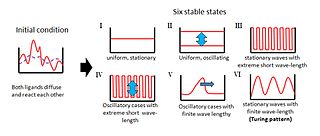
Back نمط تورينج Arabic Turing-Mechanismus German Patrón de Turing Spanish الگوی تورینگ Persian Padrão de Turing Portuguese


The Turing pattern is a concept introduced by English mathematician Alan Turing in a 1952 paper titled "The Chemical Basis of Morphogenesis" which describes how patterns in nature, such as stripes and spots, can arise naturally and autonomously from a homogeneous, uniform state.[1][2] The pattern arises due to Turing instability which in turn arises due to the interplay between differential diffusion (i.e., different values of diffusion coefficients) of chemical species and chemical reaction. The instability mechanism is unforeseen because a pure diffusion process would be anticipated to have a stabilizing influence on the system.
- ^ Turing, Alan (1952). "The Chemical Basis of Morphogenesis" (PDF). Philosophical Transactions of the Royal Society of London B. 237 (641): 37–72. Bibcode:1952RSPTB.237...37T. doi:10.1098/rstb.1952.0012. JSTOR 92463. S2CID 120437796.
- ^ Stewart, Ian (1998). Life's Other Secret: The New Mathematics of the Living World. Allen Lane: The Penguin Press. pp. 138–140, 142–146, 148, 149, 151, 152. ISBN 0-713-99161-5.
© MMXXIII Rich X Search. We shall prevail. All rights reserved. Rich X Search